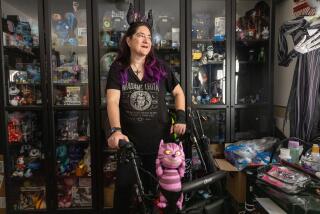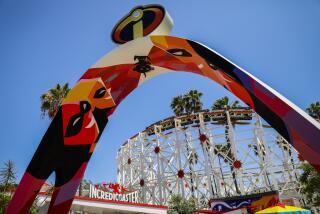Amusement Parks Feel First Lash
- Share via
The days of self-policed California theme parks are over.
Last week, in their first major accident report, newly empowered state investigators sent a clear and authoritative message that may signal how they will approach a year-old state law regulating amusement parks, according to many park insiders.
The state ordered Disneyland--run by the biggest and most powerful theme park conglomerate in the world--to make major design and safety changes before reopening the Roger Rabbit Car Toon Spin, a ride that left a 4 1/2-year-old boy severely brain damaged in a Sept. 22 accident.
State officials “took the bull by the horns,” said David Collins, a ride engineer who has worked for Disney and Universal Studios. “The fact that they did this is courageous and responsible, and their reaction is equal to the magnitude of this incident.”
Not everyone is cheering, especially at amusement parks, where officials until now have answered mostly to themselves.
As long as they could work cooperatively with the state, park officials grudgingly have accepted the oversight called for in the much-fought legislation. They now must report injury accidents to the state Division of Occupation Safety and Health or DOSH, which now is empowered to conduct annual inspections.
Now that technical regulations to enforce the law are being drafted, the report’s entry into the complex world of ride design appears to have unleashed a wave of resentment and anger. Industry insiders privately question whether the state has the technical expertise to inspect rides, much less order sweeping design changes.
“If there’s a problem, fix it, but let’s not go in as adversaries,” said Jack Falfas, Knott’s Berry Farm’s vice president and general manager.
“I’m afraid that’s the way it’s set up right now,” said Falfas, emphasizing that he hadn’t read the Roger Rabbit report. “And it shouldn’t be, because we’re here for a common goal.”
That common goal, no one disputes, is safer parks.
“I never wanted to see an increase in bureaucracy,” Falfas said. “I wanted to see another set of eyes to help prevent problems.”
When Gov. Gray Davis signed the bill into law in October 1999, it ended a 30-year battle to pass such legislation. Amusement park lobbyists squelched at least four previous attempts at government oversight. The bill by state Sen. Tom Torlakson (D-Antioch) passed at a time of mounting public concern following a string of high-profile accidents, including the 1998 death of a Washington state tourist when a cleat pulled loose from Disneyland’s Columbia Sailing Ship.
Torlakson said the state agency’s report on the Roger Rabbit accident shows the law is working as he envisioned.
“I intended the law to increase safety, to have state inspections, to have the benefit of those inspections result in recommendations to actually improve safety,” he said. “I am pleased with the actions of the Division of Occupational Safety and Health.”
On Sept. 22, Disneyland immediately reported the accident on Roger Rabbit as required by law. Brandon Zucker, a child from Canyon Country in northern Los Angeles County, fell off the spinning ride and was trapped beneath the following “taxicab” for about 10 minutes before being freed. He suffered severe brain damage and remains hospitalized.
After a three-month investigation, the state report last week concluded that Disneyland employees did not follow the park’s safety procedures for seating children away from the door. They also found that the lap bar was probably not lowered completely.
The state is ordering Disneyland to somehow close the car entryways and add a sensor-equipped guard around the bottom of each car before the ride can be reopened to the public.
Disneyland disputes the state’s findings. They say their employees acted properly and that the ride--in its current design--already is safe.
Although representatives of several parks across California declined to comment publicly, many said privately that they fear the state’s intervention and would resent being told how to fix a ride. Some have even questioned the quality of the state’s investigation as well as the report, which draws some of its conclusions based largely on comments from Brandon Zucker’s parents.
“I think the state has a long way to go in learning how to conduct investigations and structure reports from a technical point of view and a legal point of view,” said one ride engineer, Edward Pribonic of Seal Beach, who has worked for Disneyland. “And their first effort has been lacking in both areas.”
Attorney Boyd Jensen, who often represents amusement parks, said the report may “cast a shadow” over future regulatory proceedings.
Susie Storey, a spokeswoman for the International Assn. of Parks and Attractions, said her organization is concerned about additional regulation.
“Politically, it’s just another layer the parks have to go through,” Storey said, adding that more regulation does not guarantee an accident will never occur.
State officials, admittedly caught between parents and child welfare advocates on one side and a powerful theme park industry on the other, defended their findings. And Disneyland, despite its disagreement, continues to work with the state.
“This was the first opportunity for both DOSH and Disneyland to operate under this new law,” Disneyland spokesman Ray Gomez said. “The process of that, in our opinion, worked well. We cooperated fully with DOSH. They worked very, very hard on the report. At this point, we don’t want to second-guess how they conducted the investigation.”
The state took a similarly conciliatory stance.
“It was our first major investigation, and I stand by the report our investigators generated,” said Len Welsh, the agency’s special counsel. “We not only have jurisdiction under the law to do the investigation we did but the obligation to do it and to prescribe what safety measures we deem necessary to protect the public. . . . It’s never going to be easy to resolve an accident of the magnitude we’re talking about. What comes out of accidents like that is not going to be fun for anybody.”
State officials spoke with Disneyland representatives on numerous occasions during the months-long investigation. The bottom line, Welsh said, is that Disneyland agreed to make all the changes. If they did not agree with the corrective action, they could have legally challenged the state’s orders. However, any challenge would have lengthened the process.
In addition to investigating injury accidents, the state now has jurisdiction over ride inspections. How far they take that duty is another untested area.
‘If we conclude, based on our inspection, that a ride is unsafe, we have the authority to close the operation . . . pending implementation of whatever change is necessary,” Welsh said. “We’re not going to use that authority lightly.”
The fact that a ride may resemble Roger Rabbit, for example, would not, on its own, be enough for the state to conclude a ride is unsafe, Welsh said.
Kathy Fackler of La Jolla, whose son’s foot was partially amputated because of an accident at Disneyland, said she understands the industry’s apprehension but believes state oversight is necessary.
“In my opinion, the state cannot allow a ride to operate that has almost killed a 4-year-old kid who did nothing but just fall out of a ride,” Fackler said.
“I wish there could be a more cooperative venture, but that’s a two-way street,” she said. “If a park is going to be resistant to outside opinion, then they may have to be forced to make changes that they don’t like.”
More to Read
Inside the business of entertainment
The Wide Shot brings you news, analysis and insights on everything from streaming wars to production — and what it all means for the future.
You may occasionally receive promotional content from the Los Angeles Times.











